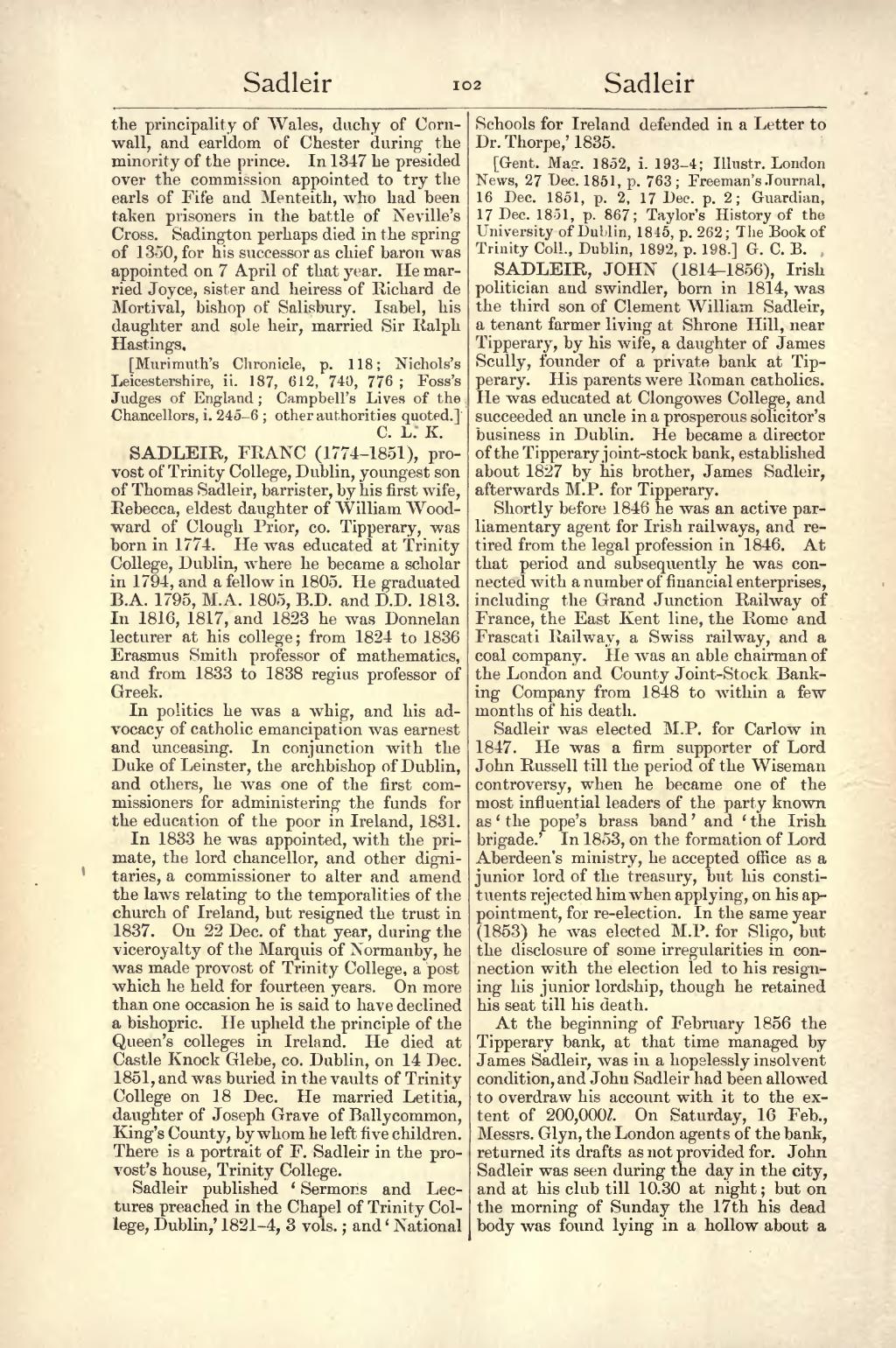the principality of Wales, duchy of Cornwall, and earldom of Chester during the minority of the prince. In 1347 he presided over the commission appointed to try the earls of Fife and Menteith, who had been taken prisoners in the battle of Neville's Cross. Sadington perhaps died in the spring of 1350, for his successor as chief baron was appointed on 7 April of that year. He married Joyce, sister and heiress of Richard de Mortival, bishop of Salisbury. Isabel, his daughter and sole heir, married Sir Ralph Hastings.
[Murimuth's Chronicle, p. 118; Nichols's Leicestershire, ii. 187, 612, 740, 776; Foss's Judges of England; Campbell's Lives of the Chancellors, i. 245–6; other authorities quoted.]
SADLEIR, FRANC (1774–1851), provost of Trinity College, Dublin, youngest son of Thomas Sadleir, barrister, by his first wife, Rebecca, eldest daughter of William Woodward of Clough Prior, co. Tipperary, was born in 1774. He was educated at Trinity College, Dublin, where he became a scholar in 1794, and a fellow in 1805. He graduated B.A. 1795, M.A. 1805, B.D. and D.D. 1813. In 1816, 1817, and 1823 he was Donnellan lecturer at his college; from 1824 to 1836 Erasmus Smith professor of mathematics, and from 1833 to 1838 regius professor of Greek.
In politics he was a whig, and his advocacy of catholic emancipation was earnest and unceasing. In conjunction with the Duke of Leinster, the archbishop of Dublin, and others, he was one of the first commissioners for administering the funds for the education of the poor in Ireland, 1831.
In 1833 he was appointed, with the primate, the lord chancellor, and other dignitaries, a commissioner to alter and amend the laws relating to the temporalities of the church of Ireland, but resigned the trust in 1837. On 22 Dec. of that year, during the viceroyalty of the Marquis of Normanby, he was made provost of Trinity College, a post which he held for fourteen years. On more than one occasion he is said to have declined a bishopric. He upheld the principle of the Queen's colleges in Ireland. He died at Castle Knock Glebe, co. Dublin, on 14 Dec. 1851, and was buried in the vaults of Trinity College on 18 Dec. He married Letitia, daughter of Joseph Grave of Ballycommon, King's County, by whom he left five children. There is a portrait of F. Sadleir in the provost's house, Trinity College.
Sadleir published ‘Sermons and Lectures preached in the Chapel of Trinity College, Dublin,’ 1821–4, 3 vols.; and ‘National Schools for Ireland defended in a Letter to Dr. Thorpe,’ 1835.
[Gent. Mag. 1852, i. 193–4; Illustr. London News, 27 Dec. 1851, p. 763; Freeman's Journal, 16 Dec. 1851, p. 2, 17 Dec. p. 2; Guardian, 17 Dec. 1851, p. 867; Taylor's History of the University of Dublin, 1845, p. 262; The Book of Trinity Coll., Dublin, 1892, p. 198.]
SADLEIR, JOHN (1814–1856), Irish politician and swindler, born in 1814, was the third son of Clement William Sadleir, a tenant farmer living at Shrone Hill, near Tipperary, by his wife, a daughter of James Scully, founder of a private bank at Tipperary. His parents were Roman catholics. He was educated at Clongowes College, and succeeded an uncle in a prosperous solicitor's business in Dublin. He became a director of the Tipperary joint-stock bank, established about 1827 by his brother, James Sadleir, afterwards M.P. for Tipperary.
Shortly before 1846 he was an active parliamentary agent for Irish railways, and retired from the legal profession in 1846. At that period and subsequently he was connected with a number of financial enterprises, including the Grand Junction Railway of France, the East Kent line, the Rome and Frascati Railway, a Swiss railway, and a coal company. He was an able chairman of the London and County Joint-Stock Banking Company from 1848 to within a few months of his death.
Sadleir was elected M.P. for Carlow in 1847. He was a firm supporter of Lord John Russell till the period of the Wiseman controversy, when he became one of the most influential leaders of the party known as ‘the pope's brass band’ and ‘the Irish brigade.’ In 1853, on the formation of Lord Aberdeen's ministry, he accepted office as a junior lord of the treasury, but his constituents rejected him when applying, on his appointment, for re-election. In the same year (1853) he was elected M.P. for Sligo, but the disclosure of some irregularities in connection with the election led to his resigning his junior lordship, though he retained his seat till his death.
At the beginning of February 1856 the Tipperary bank, at that time managed by James Sadleir, was in a hopelessly insolvent condition, and John Sadleir had been allowed to overdraw his account with it to the extent of 200,000l.. On Saturday, 16 Feb., Messrs. Glyn, the London agents of the bank, returned its drafts as not provided for. John Sadleir was seen during the day in the city, and at his club till 10.30 at night; but on the morning of Sunday the 17th his dead body was found lying in a hollow about
